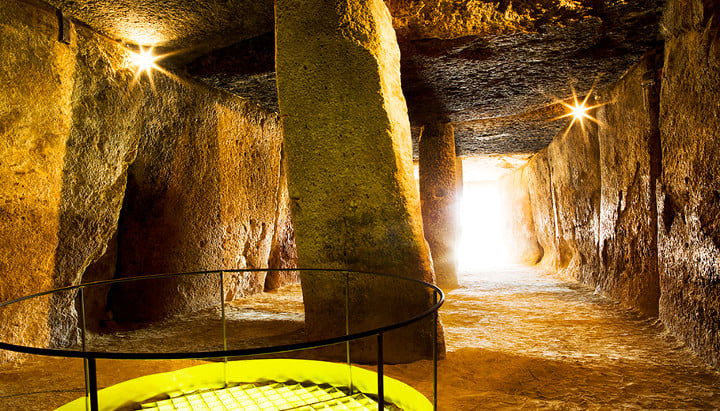The Dolmen Site may be declared a UNESCO World Heritage Site in July 2016. The candidature includes the Torcal and the Peña de los Enamorados, which are in Antequera, a major crossroads in Andalusia located to the north of the province of Málaga.
Its historical, architectural and cultural interest, spectacular landscapes and culinary offering make this town one of the most attractive places to visit inland from the Costa del Sol. As well as the Dolmens, it conserves an extensive archaeological and architectural heritage from the past, with numerous churches, convents and mansions from different periods and styles.
The Torcal de Antequera Natural Area
Of special note in the surrounding region, there is the Torcal Natural Area, famous for the capricious and fantastic shapes of its limestone rocks, which comprise one of the most important karst landscapes in Europe, and the Peña de los Enamorados (the Lover's Rock), which is known by this name due to the legend that a couple in love (a Christian and a Moorish princess) threw themselves off the crag into the void, in order to remain together for all eternity.
Archaeological Ensemble of the Antequera Dolmens
On the outskirts of the town, the Archaeological Ensemble of the Antequera Dolmens comprises the dolmens of Menga, Viera and El Romeral, and it is one of the finest and best-known examples of European megalithic culture. The megaliths are the first forms of monumental architecture in European Prehistory, and they were constructed around 6,500 years ago for funerals or other rites.
The Torcal de Antequera Natural Area
The Torcal de Antequera Natural Area - located in the municipal districts of Antequera and Villanueva de la Concepción - contains one of the most impressive karst landscapes in Europe, covering an area of 1,171 hectares. Two hiking routes provide an invitation to walk through the area and contemplate the curious forms that the rocks have adopted, becoming natural sculptures in the process.
There are also holm oaks, Algerian oaks and maples in this landscape, which live alongside plants that have adapted to living in the fissures of the rocks. The fauna in this area includes birds such as the griffon vulture and the eagle owl, and mammals such as foxes and weasels. An essential and spectacular stopping place is the Las Ventanillas viewpoint, facing the valley of the Campanillas river, with beautiful panoramic views of the landscape and Villanueva de la Concepción.
The Peñón de los Enamorados and its legend
Finally, the Peña de los Enamorados is a limestone crag with a very particular form, as it looks like the head, or face, of an Indian lying down. For this reason it is also known as "the Indian of Antequera". Its name comes from a legend according to which Ibrahim, the governor of Archidona castle, had a beautiful daughter called Tagzona, whom he promised in marriage to the old commander-in-chief of the Alhama fortress.
Tagzona was in love with Hamet, a young descendant of the Abencerrages, a prominent family, from Antequera. The young lovers, in the face of the impossibility of living out their romance, decide to flee, looking for Christian territory and, seeing that they are being followed by Ibrahim's soldiers, cross the Guadalhorce river and seek refuge on the Peña. When it is inevitable that they will be captured they decide to throw themselves into the abyss, sealing their love forever.








